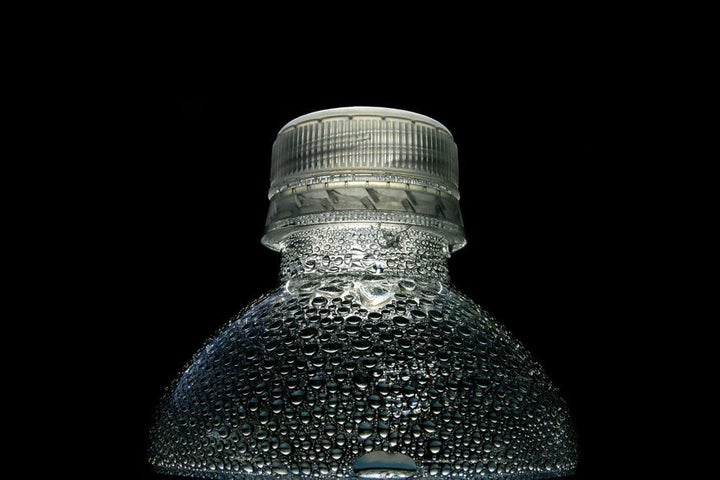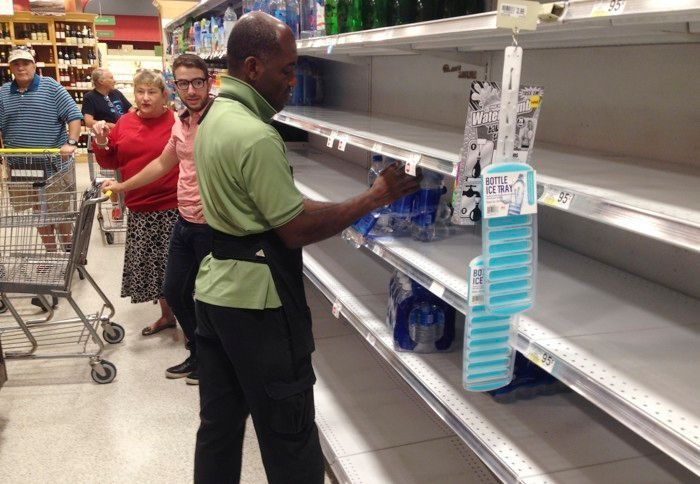
For more than 24 hours, Hurricane Irma has maintained winds of 185 miles per hour. That combination of strength and duration hasn’t been recorded over the Atlantic Ocean before. The storm appears to be heading toward the coast of Florida, and mandatory evacuations have been ordered in the Keys. Much of the rest of the state is bracing for emergency. Residents of South Florida began taking early precautions nearly a week in advance. Among them: buying tremendous quantities of bottled water.
The emergency guideline from the Centers for Disease Control and Prevention is to keep on hand at least one gallon of water per person and pet, presumably not counting fish. Many Floridians descended on grocery stores, where aisles of bottled water were reportedly dwindling or already empty as early as Monday — five to six days before the storm is projected to potentially make landfall.
That early grocery rush could leave people without bottled water. Making matters worse, prices of bottled water on Amazon have reportedly increased since news of the hurricane broke. Even at regular prices, preparing for the CDC-recommended two weeks with cases of bottled water conceivably could cost a family of four with one dog more than $500 if they could only find 16-ounce bottles.
Certain corners of the internet have surfaced a technique for water preservation that is applicable in just such an instance. As long as the municipal water system is still intact, “tap water” can be run from a faucet into a storage vessel — a jug, if you will. A canteen or large bottle will also work, as will a food-grade watertight sack.

An employee restocks bottled water on bare shelves as customers wait for him at a Publix grocery store on September 5, 2017.
Factory-bottled water costs around 2,000 times as much as artisanal-bottled water. The former is usually not recommended to be stored for longer than two years, while the latter can be stored for up to six months.
“Well, I don’t have a jug!” some people might say.
The nice thing about jugs is that they are purchasable and reusable. They keep until whenever you need them, and they are environmentally less costly to ship than cases of bottled water. This means less burning of fossil fuel, and so less carbon flowing into the atmosphere, and so less warming of the oceans, and so less intensification of the very weather patterns that bring about the need for stockpiling water.
Disaster-preparedness experts recommend that people invest in quality vessels if possible. Choosing the optimal way to store gallons of water for any given home isn’t necessarily obvious, and it depends on geography. Sources in the San Francisco Bay Area have informed me that many households maintain full tanks of water for use after the next earthquake. Among the popular options are large, polyethylene barrels, some of which are equipped with taps (like kegs) and hold up to 55 gallons of water. Water can be safely stored in these kegs for years, according to some experts, when they’re well cleaned and sealed.
Of course, making space for a large sturdy barrel in a city where real estate costs something like $8,500 per square foot is a privilege not afforded to all. The same problem of space presents itself in New York, where some apartments are barely larger than bedrooms, and in my experience almost none have water barrels. Keeping a 55-gallon barrel of water on a high shelf to save space creates its own set of risks upon arrival of a natural disaster.
In cases where storage is limited, collapsible five-gallon containers can be purchased cheaply and easily stored in even a modest-sized crack in a wall. Hurricanes afford time for preparation that earthquakes do not, namely time to fill one’s vessels.
“Hurricanes afford time for preparation that earthquakes do not, namely time to fill one’s vessels.”
Even if the municipal water system does fail or become contaminated, as some did in Texas in the wake of Harvey, tap water can be made potable in various ways. The CDC advises adding a tiny bit of bleach, one teaspoon of 5.25-percent sodium hypochlorite per gallon of water. If anything, grocery stores should be selling out of bleach.
For preventing dehydration, water alone should be sufficient, unless you’re fasting and sweating profusely or have cholera or another sort of diarrhea. Those conditions could leave people with electrolyte deficiencies, in which case oral rehydration solution can be purchased and kept on hand, of the same formulation that is used by the World Health Organization during cholera outbreaks. Since dehydration is among the leading causes of death globally (often due to infectious diarrhea, outbreaks of which are common after a natural disaster), oral rehydration solution has proven to be one of history’s most effective, life-saving medical interventions.
If you find yourself without any sort of bottled water — artisanal or factory — and your water supply is contaminated and you have no bleach or ability to boil or otherwise purify water, then there is usually some drinkable water in your hot-water heater and in the tanks of your toilets. The tanks, not the bowls.
This story originally appeared on TheAtlantic.com.
More from The Atlantic: Why Happy People Cheat, The First White President